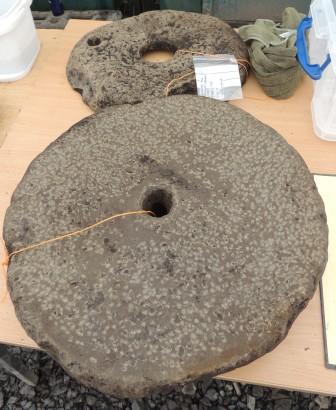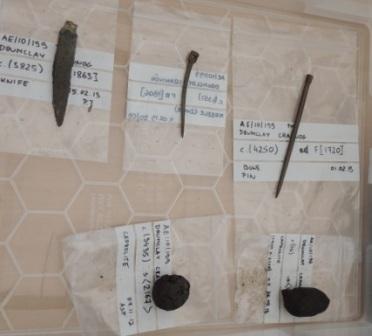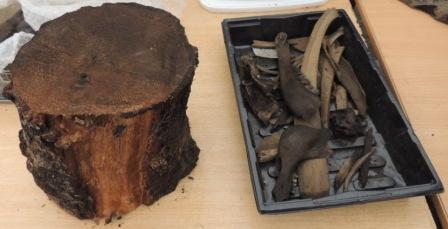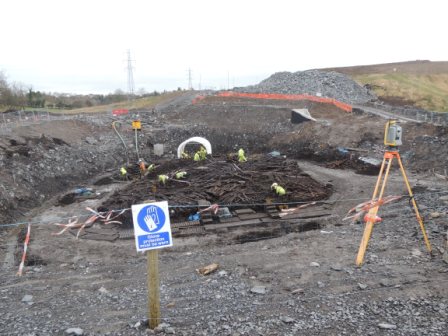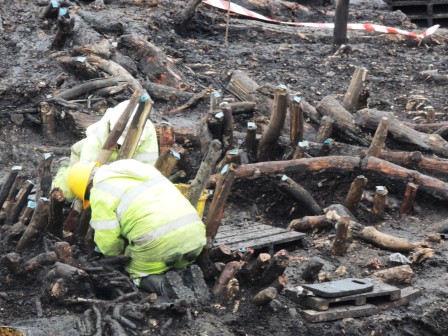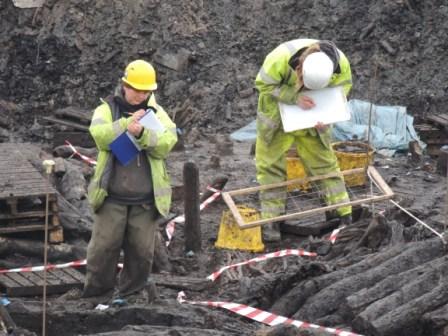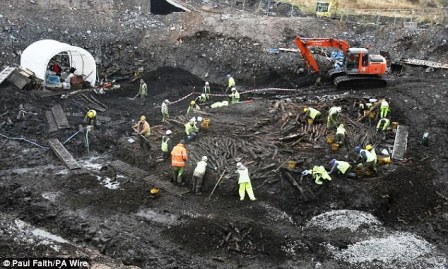|
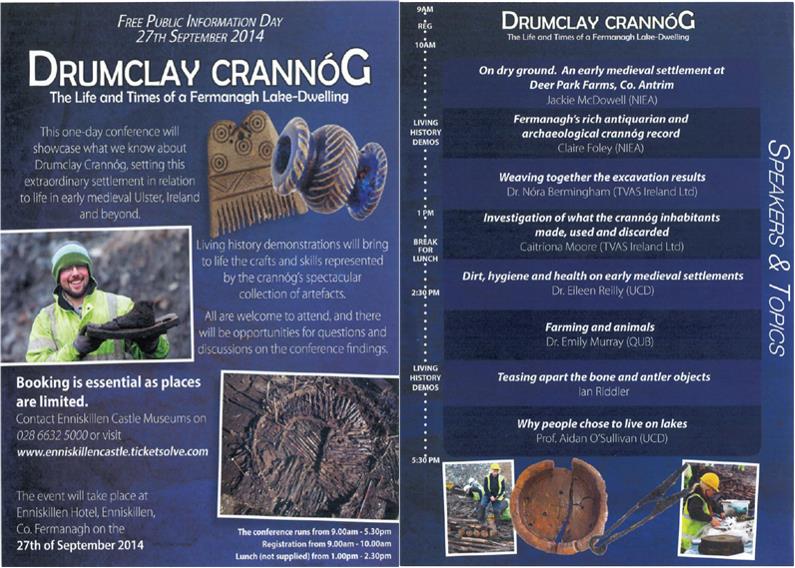 |
|
 On Saturday
September the 27th, almost a year and a half after the completion
of the excavation at Drumclay a seminar 'Drumclay Crannog - The
Life and Times of a Fermanagh Lake-Dwelling' was held in the
Enniskillen hotel to diseminate the intitial findings from the
ongoing post excavation work on the Drumclay excavation. Having
travelled from Dublin to two of the Open days in 2013, I
travelled again with anticiaption to the Seminar in Enniskillen.
I was not disappointed, it proved to be a very informative day
and as one speaker stated "Drumclay has not lost its WOW factor". On Saturday
September the 27th, almost a year and a half after the completion
of the excavation at Drumclay a seminar 'Drumclay Crannog - The
Life and Times of a Fermanagh Lake-Dwelling' was held in the
Enniskillen hotel to diseminate the intitial findings from the
ongoing post excavation work on the Drumclay excavation. Having
travelled from Dublin to two of the Open days in 2013, I
travelled again with anticiaption to the Seminar in Enniskillen.
I was not disappointed, it proved to be a very informative day
and as one speaker stated "Drumclay has not lost its WOW factor".
 The audience at the booked out conference heard 8 excellent
lectures giving insights into the initial post excavation work
that has been undertaken, and how Drumclay Crannog is going to
complement and in some instances change our current understanding
and interpretation of crannogs and life in the Early Medieval
period and the continuing occupation of some crannogs up to the
Post Medieval preiod. The audience at the booked out conference heard 8 excellent
lectures giving insights into the initial post excavation work
that has been undertaken, and how Drumclay Crannog is going to
complement and in some instances change our current understanding
and interpretation of crannogs and life in the Early Medieval
period and the continuing occupation of some crannogs up to the
Post Medieval preiod.
|
|
In addition to the lectures, three living history
demonstrations gave an interesting insight into Early Medieval
crafts of Wood truning, bone working and spining yarn.
|
|
 
| 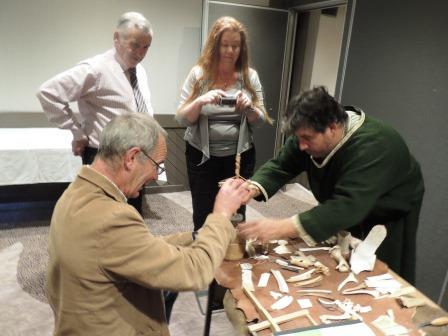 Ricardo demonstrating how to work bone. Ricardo demonstrating how to work bone.
|
|
Below are some highlights from the Conference lectures
based on the snippets I manage to note. The conference was opened
by Dr John O Keeffe, DOE, NIEA.The first session was entitled
Setting the scene: The archaeological context of Drumclay
crannog. Jackie McDowell gave an overview of the Deer Park
Farms excavation an Early Medieval raised Rath site which similar
to Drumclay had remarkable level of preservation of organic
material. Clare Foley in her lecture gave an overview of Crannogs
with a focus on County Fermanagh. |
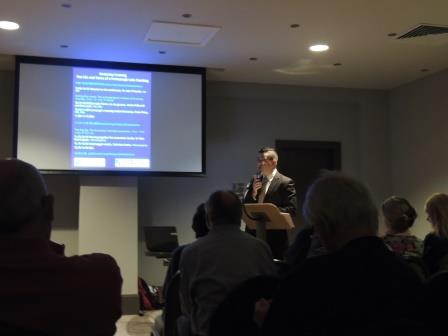 |
Setting the scene: The archaeological context of Drumclay
crannog
Deer Park Farms: on dry ground. Jackie McDowell, DOE,
NIEA
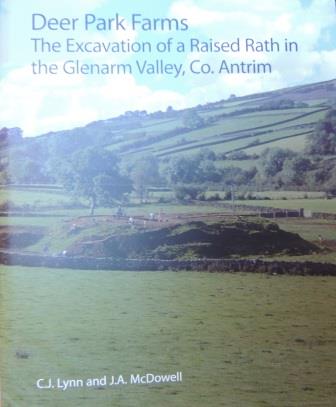 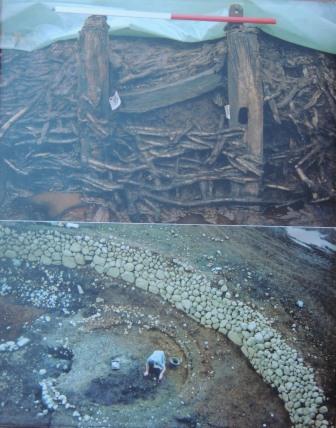
- There are over 45,000 raths/ringforts known in Ireland
- Deer Park Farms, a raised Rath in County Antrim excavated in
the 1980s.
- This site provided an excellent insight into life in an Early
Medieval Rath due to its exceptional preservation.The lower
layers of the site were water logged and there was good
preservation in the upper layers also because material was buried
and not disturbed by subsequent activities such as
agriculture.
- Over 3,500 artefacts were recovered from Deer Park Farms,
many of them organic.
- A lot of prehistoric flint and polished axe heads were found
on the site. Were these people in the Early Medieval also
interested in discovering their past.
- Throughout the life of the Rath the houses constructed and
rebuilt had a uniform plan.
- In the upper layers of het Rath evidence uncovered shower 3
phases of house all destroyed by burning. Metal remains were
found in the burnt layer.
- The upper layers of the Rath also had 2 souterrains, and some
pottery fragments were also found.
- The evidence from the Rath suggests that mixed farming was
practiced by its inhabitants with cattle predominant.
Fermanaghs crannogs before Drumclay. Claire Foley, DOE,
NIEA
- The Drumclay crannog was built up as it sunk beneath its own
weigth.
- About 2000 known crannogs in Ireland mainly in the inter
Drumlin lakes.
- There are 142known Crannogs in county Fermanagh
- In 19th Century Fermanaagh was famous for its crannogs
- The Antiquarian'W F Wakeman' visited and recorded crannogs in
County Fermanagh and recovered some artefacts which he also
recorded and drew in detail.
- Original archaeological thinking on crannogs was that you
could just see one archaeological layer - Drumclay has changed
this interpretation.
- In building crannogs there was a preference for smaller
isolated lakes as crannog sites - easily defended
- No crannogs are found in larger lakes
- 1977 Crannog Survey in County Fermanagh (1977 was
anexceptionaly dry year with the lakes levels much lower than
normal.
-
- 1977 Crannog Survey Aims
- Confirmation by observation
- Crannog Diamater recorded
- Sample timber taken from Crannog (one phase)
- Causeway? (none were found)
- Dating: Dendro and C14
- 154 crannogs suveyed
- 65 have no surface expression ie perminantly submerged
- Only 2 were identified in the original Ordnance Survey of the
cCounty.
- Crannog Date ranges: Late bronze age to 17th Century
- Research value of Crannogs
-
- Wetland enviroment - potential for excellent
preservation
- Wooden structure and objects
- Leather shoes , bone, combs hair
- Parasites, insects
- Cloth, plant remains
- Metal, pottery
- Evidence suggests that people of status having a shared way
of living - in crannogs and on raths/ringforts
|
The big dig: The Drumclay Crannog excavations
Session 2 of the conference was chaired by Professor Aidan O
Sullivan of UCD entitled The big dig: The Drumclay Crannog
excavations. focused on the Drumclay excavation and some
initial findings from the excavation. In this session Dr Nora
Berminham the site director on the excavation gave an overview of
how the crannog at Drumclay was constructed and the cycles of
maintaining the Crannog and its houses over time. Caitriona Moore
who also worked on the excavation in her lecture then gave an
overview of some of the 6000 artefacts recoverd in the excavation
of Drumclay Crannog with a special focus on the wooden artefacts
her specialisation.
Weaving together the excavation results. Dr Nora Bermingham,
TVAS (Ireland) Ltd |
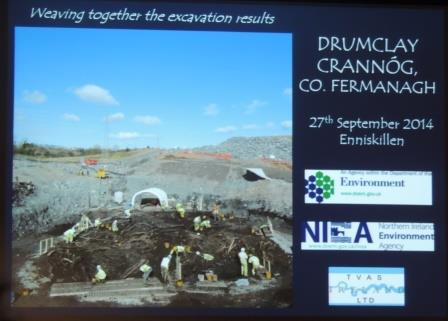
| Drumclay crannog was sited in a small inter Drumlin lough
as mapped by the Ordnance Survey in the early 19th Century.The
Crannog was sited within 30m of high dry ground which has no
enclosure evidence. It was visited by the antiquarian W F Wakeman
in 1870s, however he records that access to the site was not
possible due to the swampy conditions of the surrounding area.
Before excavation Its surface expression was a low mound 15m in
diameter growing to a 26 x 18m mound as excavated down. |
- How Drumclay Crannog was built.
-
- Piles droped in lake bed (oak , alder)
- 1: Birch poles driven down into lake bed. Crannogs moved as
organic.
- 2: Build up network of platforms - stacked like pancakes 10
ot 12m in diameter. When platform built they started living on
them. 100s of logs used overlapping layers of wood eg 12 layers
in western side platforms. Platforms also retained by wattle
walls.
- Open areas in middle of the platforms 2m sq. These were used
as the hearths (filled in).
- 53 platforms identified - increasing the ground surface above
water level.
- Houses
-
- Rectangular Houses
- Round and figure of 8 Houses
- 18 houses positively identified to date
- Houses built and rebuilt in same location
- We don't know
-
- How many standing and inhabited at the same time
- How often houses were repaired or replaced
- If lived in all year round or seasonally
- Could be several houses have been occupied at same time.
- Who lived where on the crannog.
- Houses were dismantled before rebuilding
- Houses were always built around the hearths
- Round house which may have an extension identified 6 - 6.5m
in diameter
- Inside a house
-
- Very few internal roof supports.
- Internal subdivision
- Stone break hearths, rectangular clay lined and stake
holes
- Moving around the crannog - Series of pathways silt and
stone, some built of wood
Top layers of Drumclay Crannog excavated
- From wood to mud - living on a crannog mound. Houses had
cobbled yard.
- When not using wood, clay used to build platforms
- Top 2m : clay floors and/or hearths
- Home for living and dead
- One set of human remains found - a woman of 18
- Unusual burial for this period (14th Century)
- Evidence of stress in her life.
- Initial Dates from Drumclay
- Late 7th-10th Century: 3 platforms 676-866, 695-887. (Crannog
is likely to be no older)
- One house dated to late 10th-12th Century (Turbelent period
in area 995-1153)
- 13th Century house AD 1213-1279 (Maguires)
- 14th-15th Century House AD 1326-1443
- 1309-1439 - Skeleton of young female. (Maguires establish
stronghold in Enniskillen)
- The Crannog continued in use up to the 16th century.
|
Waterlogged wealth. Caitriona Moore, TVAS (Ireland) Ltd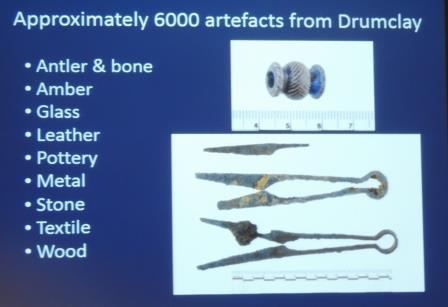 | 6000 artefacts
were recovered by the excavation from Drumclay, compared to 3500
recovered from the Deerpark farms site. There is still much work
to be done on this large artefact assemblage from the
excavation. |
|
Over 1000 wooden artefacts were recovered from the site - this
is unprecedented in Irish Archaeology
- These included
-
- Food storage /preparation
- Tableware
- Utensils
- Textile production
- Leather
- Transport
- Evidence that it was a high status site
- Domestice production
- For making wooden artefacts many of the craft techniques used
in the Bronze age continued in use in the Early Medieval
period.
- An intact wood carved keg and carved trough were found on the
site.
- A wooded dish thought to be a cheese mould -
(likely alder as alder used a lot tableware and utensils as the
wood did not flavour food) unparalleled in Irish record was found
at Drumclay. Similar to ceramic roam cheese moulds. Cross
enscribed in base - lot of superstition in dairy world.
-
Evidence of woood turning found on site. Wood Turning was used
to produce Cups, plates, bowls and gaming pieces.A wood turned
plate recovered had been repaired with copper wire, evidence that
the plate was a valued item. 
- Evidence for coopering was also found on the site. Over 100
wooden staves recovered in the excavation in addional to wooden
discs for the base of barrels. Some Metal and wooden hoops also
found on the site.
- Some fragements of decorated wooden vessles also found
including some with evidence of pokerwork (design pattern burnt
into surace of vessel.) Much of this material was recoverd from
the saame area on the crannog. Other decoration included
christian symbols.
- Small utensils also found on the site included carved spoons,
iron knives
- Evidnce of textile production at Drumclay in the artefacts
found included, Spindles,a Distaff and whorls.
- Leather Working evidence included a lot of scrap leather and
a wooden shoe (shoe size 5) last.
- The excavation also gave a small insight into leisure
activities on the Crannog.A gaming board found though in bad
condition in addition to 15 gaming pieces found both finished and
unfinished. A tuning piece for a musical instrument was also
found.
- Three spearheads were found and a couple of axes together
with a possible part of a long bow showing that at some stages
the Crannog occupants werer armed.
|
Drumclay Crannog and its potential for understanding early
medieval environments and economies. Chair: J.A. McDowell
The first session of the afternoon focused on the potential of
the Drumclay excavation results to give us an insight into the
daily life of the people living on the Crannog and to add to our
overall knowledge of daily living in the Early Medieval and
Medieval periods. In the first lecture of the afternoon, Dr
Eileen Hyland gave an interesting insight into how the study of
insect remains in samples from the Deer Park Farms raised Rath in
County Antrim and the Fisamble Street excavations in Dublin
challenge some of our perceptions of Early Medieval life in both
rural and urban settings. This was followed by a lecture by Dr
Emily Murray giving some inital insights into diet and use of
animals on the Drumcly Crannog from the animal remains recovered
in the excavation at Drumclay
Dirt, hygiene and health on early medieval settlements. Dr
Eileen Reilly, UCD School of Archaeology.
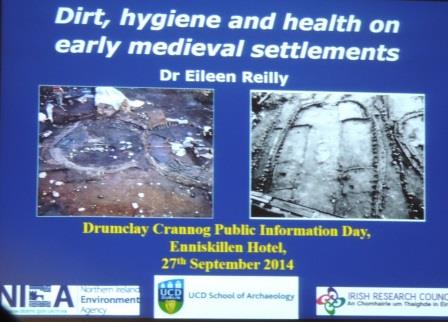
- Evidence for living conditions
-
- Attitude to dirt and cleaniness and legacies of biological
and cultural aversions have led to a 'dirt ridding culture'.
- Middens, dung heaps
- Cess and rubbish pits
- Dumping beyond the palisades in enclosures
- Grooming
- Evidence
-
- Insects (Beatles,flies, lice etc - proxy for how people lived
in thepast, reflect how people lived)
- Intestinal parasites
- Plant remains
- Animal bone
- Human remains
- Literary evidence
|
- Examining the evidence from two Early Medieval
sites
- Deer park farms (DPF) - 7th -12th C - Rural Settlement
- Fishamble Street - 10th-11th C - Early Urban streetscape
- Interior of House
- Smell of wood smoke permiated all
- Bedding area: Very clean and dry - bed consisted of wood
chip, straw, bracken etc
- Insect evidence suggests clean environment
- Central floors less organic , more footfall, slightly
damper.
- High numbers of lice, animal parasites, high number of fleas
(constant)
- Evidence of lice - evidence for grooming
- Dungy, muddy ground in yardsbuilt against walls , fences etc,
Dung, urine soaked, plant metter, butchery waste
- Human parasites - evidence of outdoor grooming /washing
- Paths - cobbles, wattle plank - a necessity?
- Cess pits - human excrement, urine, household waste -
evidence of clean out and reuse of pits.
- In Rural houses, cess pits not clearly identified, ubiquitous
in urban settlements.
- Where did people go to the toilet? - human intestinal
parasite contamination identified in 2 areas on the Deer Park
Farms site. This points to the possility of an outside loo
possibly above ground, with waste regularly cleared and dumped
offsite.
- Contamination and disease
- Locations chosen for dumping not good
- Nearby water contaminated
- Reuse of human waste as fertiliser - soil and water
contamination
- Disease causes in early medieval literature usually put
(Crawford 2011) to demons etc not hygene
- Interior floors of houses clean, bedding warm and dry
- Less control over exterior space except where prescribed by
laws/culture
- Abundant lice (DPF), absent from FS, grooming essential
- Flies/Fleas/gut parasites despite efforts to keep clean
- Contamination of water - no connection at this time with
disease
- Studies of human remains
Drumclay will add to this picture. |
Farming and animals. Dr Emily Murray, School of Geography,
Archaeology and Palaeoecology, QUB.
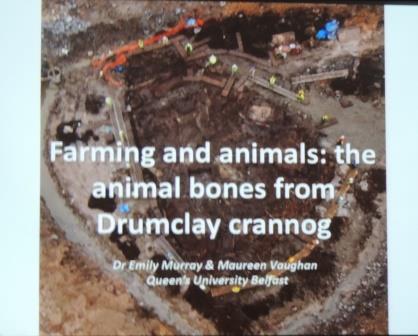
- Research Approach
- Identify range of species and percentage present body parts
present
- Determine age of animals at death (tooth wear etc)
- Sex
- Stature
- Pathologies
- Evidence for butchery, burning and other modifications
A large assemblage of animal bone has been recoverd from
Drumclay. To date, only half way through initial study of the
Drumclay assemblage. As expected the trend is similar in
different crannogs investigated, Moyarath, Sroove etc.
Drumclay
- Cattle 45%
-
- In some high status sites cattle larger. Early Medieval
cattle breeds tend to be similar to the modern 'Kerry Breed'
- Cattle slaughter trends from Early Medieval sites show them
being slaughtered at all ages. The emerging Drumclay pattern is
similar.
- Peak at 2 to 3years bracket. Trend in Drumclay for younger
animals to be also slaughtered which could indicate high status
(early as data still to be split into time line.
- Pig 41%
-
- Razorback or Greyhound pigs more likely similar to pigs in
the medieval Ireland also would have been herds of pigs - pigs
pens identified in DPF.
- Pigs 17-23months optimum age for slaughter. In Drumclay a lot
of young pigs killed.
- Sheep/goat 14%
-
- Sheep: 12-28mths. In Drumclay slight peak in younger age
slaughter .
- A lot of domestic animals - high status indicator
- The Early Medieval Irish were not fond of hunting indicated
by a lack of prey animal bone found at Early Medieval sites.
Antler bone tended to be collected rather then from hunted
animals. There is some bird and fish bone present (Salmon) in the
Drumcaly assemblage, but in small numbers
|
Drumclay Crannog and its potential for understanding early
medieval societies. Chair: Dr Nora Bermingham
The final session of the conference was opened with an
exciting lecture by Ian Riddler on how combs found at Drumclay
can help refine the dating of phases on the sight and also give
an insight into peoples lives. The final lecture of the
conference was given by Professor Aidan O'Sulivan of UCD summing
up why people may have chosen to live on Crannogs
Teasing apart the bone and antler objects. Ian Riddler and
Nicola Trzaska-Nartowski.
- Combs
-

- Combs made of bone revitted together
- Combs - private act but also public outcome
- Provide dating evidence
- Evidence of craftwork
- Using Ipswich ware pottery as an example of how comb types
can refine date ranges for an Early Medieval site.Ipswich ware
pottery has a date range of 720-850/870, but this 150year period
can be further split in 2 by comb styles
- Drumclay combs
-
- Drumclay has a sequence of combs
- Early comb 500-600 AD
- Double sided composite comb C700-800AD
- 800-925AD Cross hatch comb found at Drumclay -cross hatch
pattern found across Ireland
- Single sided combs C925-975 AD.
- Scandanavian combs, Irish copies of scandanavian combs -
Continued use of cross hatch incuding Drumclay - Also copies used
with Scandanavian designs - Drumclay 975-1175 example - made in
Dublin - someone from Dublin in Drumclay?
- 1050-1225 Undecorated single sided composite comb. Most
common type but none found yet from Drumclay
- 1175-1250 Sigle sided comb found in Drumclay
- Yet to be seen how the comb sequence relates to the
stratigraphy at Drumclay.
- 6 combs with lattice patterning - Drumclay signature/
evidence of regionalism?
- 965 230mm Drumclay comb, one of longest found in Ireland. 3
High Street combs 240mm,315mm , 375mm (975-1050 High Street
display combs)
Comb manufacture
- Antler and iron predominanatly used for rivets in Ireland,
not much copper used in Irish combs.
|
Why people chose to live on lakes. Prof. Aidan O'Sullivan and
Dr Robert Sands, UCD School of Archaeology.
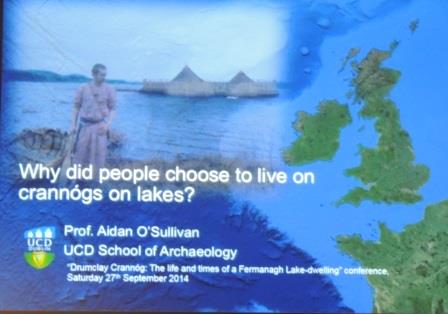
Drumclay crannog was built on a damp unstable environment,
within meters of perfect Drumlin hill. We Need to think of past
through mirror- allow the past to be seem strange to us. We need
to accept that the way Early Medieval people thought about lakes
and Crannogs mostlikely differed and thus their Motivation for
building on lakes.
- Crannogs
-
- The word crannog was not in use. Innis the word used ie
they thought of crannogs as islands.
- Percieved as places of change, remote ?, about
journeys.
- Places where heros could renegotiate on community's
behalf.
- Associated with Kingship.
- Geographical size not significant
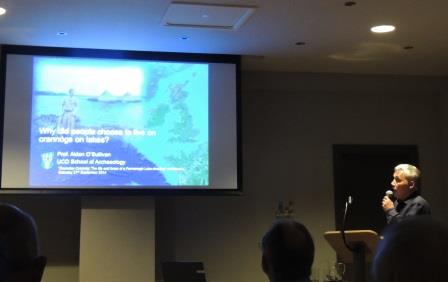
- Chronology of Crannogs
-
- Bronze age ( c1000 - 800 BC)
- Iron age (Some)
- EM explodes in use of crannogs 6th-10thC
- Late Medieval especially in NW
- Crannogs die out in post medieval
- Archaeologically crannogs are very complex sites eg Coolure
Demense - multiple dates
-
- Key for understanding site higraphies.
- How people live and work together across generations.
- Thinking about water spaces in very distinctive way
- Could crannogs be both prominent and remote and usfully
requiring a journey.
- Could they be stages for restricting access and managing
perceptions
-
- Example of Kings struggling with troublesome saints (8th C
life of Aed)
- Kings using islands to inhabit landscapes of power
- Crannogs on boundaries?
- Coolure - evidence of feasting , high status, also located
close to a large Rath
- Crannogs also occupied by all classes - ordinary people
seeking to create land in water.
- Summary
-
- 15 crannogs excavated in Ireland since 1930 none to standard
of Drumclay
- Drumclay most significant wetland site in Europe
- Unique opportunity to explore lives of people of Fermanagh
and Ireland in EM
- Potentiall rewarding at every level of archaeological enquiry
and scientific enquirey…
- Persitence of effort in the face of adversity - conditions
damp etc
- "Drumclay has not lost its WOW factor
- One place in the world
- In Early Medieval Ireland a persons reflection was only seen
in water - there were no mirrors in Drumclay
|
Drumclay Site September 2014
| 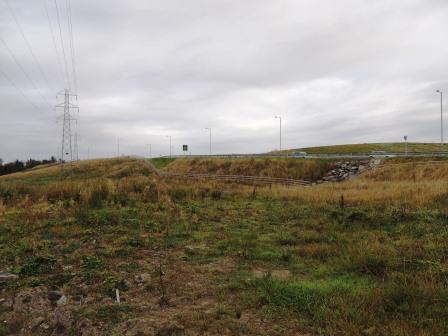 |
Drumclay Crannog Open Days 2013
Drumclay Crannog Open Day 16th Feb 2013
The excavation of Drumclay crannog which commenced in the
Spring of 2012 and is one of the most significant excavations
undertaken in Ireland in recent years, given the exceptional
preservation qualities of the site and the quantity and nature of
the finds being uncovered and the fact the full crannog is being
excavated. Some archaeologists have put the excavation on a par
with Viking Dublin in importance. I got to visit the site on the
second Public Open day held the 16th February 2013 when over 700
people took the opportunity to visit the site.
|
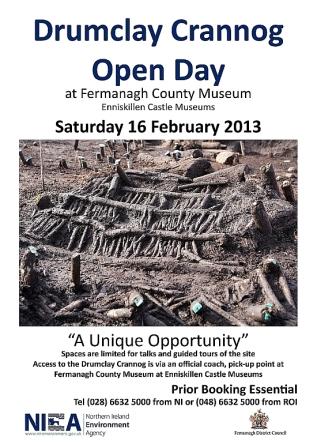 |
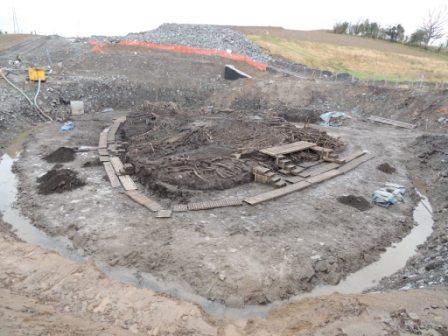 |
 |
|
The site of Drumclay crannog is just to the north of
Enniskillen and lies on the route of the new Cherrymount bypass
road. The construction of this road led to the excavation of the
crannog, a known site marked on the first edition Ordnance Survey
maps, one of over 142 Crannogs identified in County Fermanagh.
The initial delay in recognising the significance of the site has
been well documented by Robert Chappel and others, (Drumclay,
Cherrymount, a crannog in crisis)whose campaigning won time
for the site to be properly excavated.
On the first edition OS six inch map the site of Drunclay
Crannog is shown located in a small lake. Wakeman in an 1873
paper (WAKEMAN,W.F. JRSAI XII, 1872-3, 322) records that the lake
was being drained and describes the land surrounding the crannog
as a dangerous swamp. The area has remained waterlogged and boggy
giving rise to the conditions which facilitated the preservation
of the Crannog structure after the draining of its host lake. By
February 2013 the area surrounding the Crannog had been excavated
down to what was probably the bottom of the original lake.
|
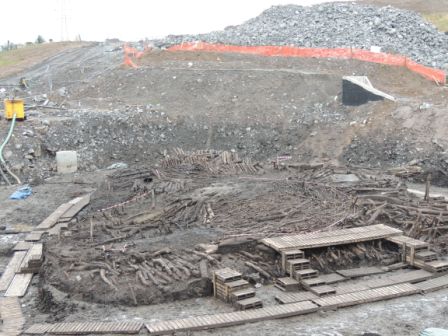 |
 |
At first sight the surviving unexcavated remains of the
crannog look like a pile of wood varying in size from tree trunk
to branches and smaller. This relects the predominance of wood in
the structure which also consists of stone and clay. Over its
lifetime the Crannog has suffered several slumps resulting in the
occupational layers being stratigraphically mixed, an added
complexity for the excavation team.
|
|
The excavation has established that the Crannog was in use as
a settlement site up to the 17th century and by the 16th of
February the excavation was revealing layers dating back to the
7th Century. To date the foundation remains of over thirty houses
built over the life time of the crannog have been identified by
archaeologists. Different construction styles have been
identified with the house type from one phase being very similar
to Viking Dublin house. Some houses had hearths of stone, others
made of compacted clay. One of the houses currently under
excavation is over 12m in diameter, one of the largest houses
uncovered to date from Early Medieval Ireland. It has a very
large central fireplace around which a series of logs were placed
to form floorboards.
|
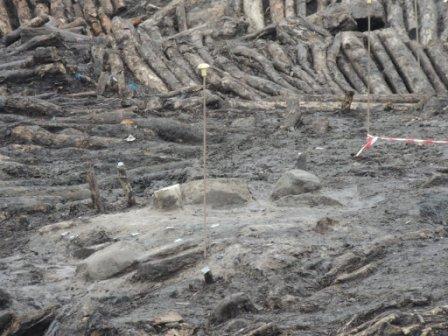 |
 |
















